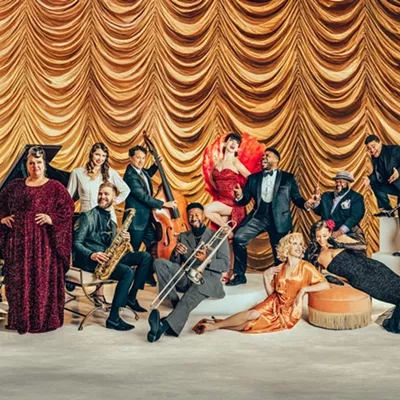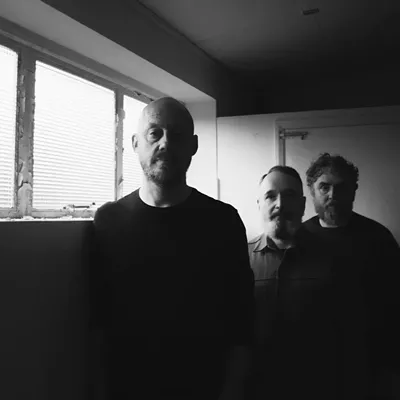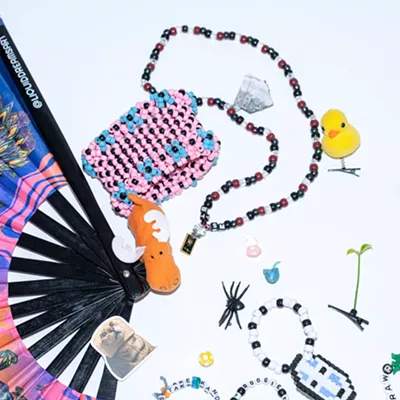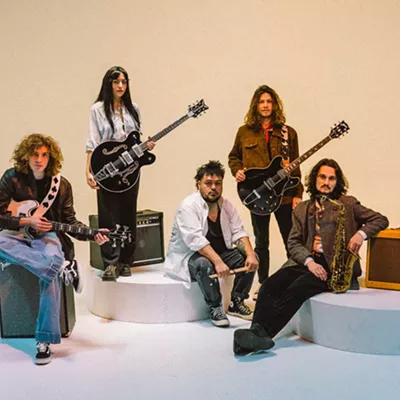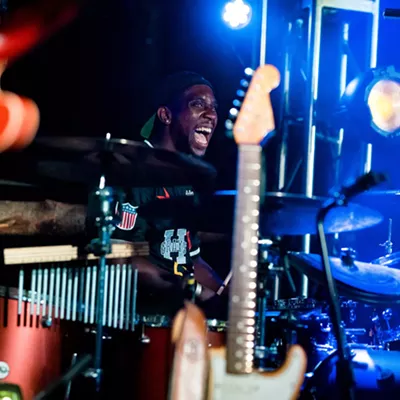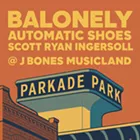Not everyone thinks that shrunken heads are funny. And who knew if David Byrne, the famous face and voice behind the Talking Heads, was trying to get people to laugh when he decided to wear an enormous version of a normal suit during Stop Making Sense? He appeared as normal, but the oversized Pee Wee Herman-esque getup made Byrne's head look just a tad too small for his newly enormous shoulders. Whatever it was, the suit was just one of those odd-yet-intriguing things that made the Talking Heads so inventive. And more than anything, it was another Byrne-ism that separated listeners into those who enjoyed the music of the Talking Heads from those who could truly understand the off-kilter insanity that was the Talking Heads.
Impossible to categorize and innovative beyond any other group that the late 1970s had seen, the Talking Heads did things for music that few other musicians had been able to -- namely tearing down the then-predefined shackles of rock music and playing up the fusion of electric instruments with traditional ones. It was a creation dreamt up by Byrne and fellow Rhode Island School of Design students, Tina Weymouth and Chris Frantz. The sound made staccato notes into melodies, and became popular when paired with the Heads' flamboyantly normal Byrne. After releasing three herky-jerky albums with the Heads, the group took a sabbatical from their hectic performing and recording schedule.
Never one to sit still, Byrne started pursuing other projects in 1981 -- pairing with Brian Eno to produce his first solo album, My Life in the Bush of Ghosts. A slave to world music and Latin beats, Byrne followed the Talking Heads' lead and fused global styles with as much electricity as he and Eno could successfully plug into one record.
But going solo didn't stop there for Byrne, and he continued his personal projects through and beyond the remainder of the Talking Heads' lifespan. The late '80s welcomed the release of his second solo album, Rei Momo, and the creation of Byrne's own record label, Luaka Bop. With such an attraction to world music, Byrne was inspired to bring such global beats to the ears of the American listeners via his label.
With a new album, a new record label, and an Academy Award for his work on the score of The Last Emperor, Byrne decided to break completely from the Talking Heads. In 1992, he retreated back to his rock roots with his third solo release Uh-Oh, and has since continued along such a path on his later solo albums (including this year's Growing Backwards).
Today Byrne stands a veritable one-man artistic think tank -- lending his expertise to every art form, from painting to ballet. He often comments that when he was growing up, he never was sure if he wanted to be an artist or a scientist -- and, in some ways, Byrne seems to have struck a balance between the two. Having created such recognizable artistic trademarks, he has created his own sort of artistic science. In whatever form that he lends his hand to, Byrne makes a unique impression -- whether it's music, film, visual art, performance or dance. All are distinctive and nontraditional in style, and most continue to be very odd. It's that sort of oddity that caters to a certain audience -- one that thinks that shrunken heads are funny and one that is open to the peculiar science of David Byrne.
Weirdly Webley -- Enigmatic might be one word to describe Jason Webley; freaky might be another. But no matter how you'd describe this vagabond Seattleite, you can't help but be captivated. This Friday the 13th at the Detour will be the perfect setting in which to get acquainted with Webley's fascinating live show. If it's anything like the reputation that precedes him, you're in for a treat.
Webley got his start in the streets of Seattle. In fact, his performances continue to draw huge crowds both on and off the street.
"I recorded the first album before ever playing on the street. I had made 1,000 of them and started playing on the street, selling them for a few dollars to get rid of them. The shows started continuing together shortly after," says Webley. The first album,Viaje, was recorded in his kitchen. True to his independent roots, this record introduced the public to a man who slings an accordion and "performs" his music rather than just plays it.
"I like how the accordion breathes and makes your body move when you play it. It sort of plays you, not the other way around. But I play a lot of instruments: piano, guitar, a bunch of things. I think the accordion is just the most memorable and visceral of them," Webley says. He has also been known to use a shaker fashioned from an old vodka bottle.
His appearance is imposing and somewhat rough, but don't be fooled by his disheveled exterior. On nearly an annual basis, Webley bids farewell to his former self in a grand ritual that has included being whisked away to sea and being tied to a tree and left for dead deep in a forest. Then, on his birthday, he reemerges as a new persona and with a new collection of music and theatrical presentations to accompany the new composition. Not your typical performer.
All this drama may seem a bit overboard, but it can be discounted as fallacy by the passion Webley exhibits in his music. Not only has the Seattle press made it known that Webley is their favorite underground son, but he has drawn the attention of the international community as well. He has performed in Russia, all over the U.S. and Canada and made an appearance at the UK's Glastonbury Festival this year. While Webley is no stranger to the road, he's most at home in his native Seattle, playing to the crowds he's known for years. This time around the world though, he is armed with his latest album, Only Just Beginning (Springman). The album finds beautifully dark songs fashioned around the ever-present accordion and lavishly soaked in Webley's harsh vocal delivery.
"On this new album, I was actually going for a smaller ensemble with a more lush sound," says Webley. "I did most of the tracking over two weeks on an island in the San Juans in an abandoned hotel."
It's difficult not to compare the songs here to the likes of the Pogues, but be assured that Webley keeps things his own and adds surreal depth to the compositions with surprises around each corner.
Open... Again? -- Ah, the Big Dipper, that nightclub of myth, legend and infamy... that accommodating but sadly underutilized space. After more false starts and restarts than I care to remember, the Big Dipper is once again poised to reclaim its rightful place in the local live music scene as a performance venue of great worth. And here I am once again, doing what I swore I'd never, ever do again: writing another "The Big Dipper is Back" story.
See, I've been burned before. Hell, we all have. We love the Big Dipper. It's a stylish, roomy venue with good acoustics and a glorious history. And so whenever some well-meaning soul announces plans to start it up again and add to the legacy, those of us in this town with the live music itch can't help but feel (guardedly) optimistic -- delighted, even -- about the prospect.
Yet I don't have fingers enough to count all the times the club has re-opened for the expressed purpose of once again hosting live original rock shows only to have the bright lights of promise snuffed out almost before the good news of its opening has hit the streets.
So it is with some caution that I report to you the (ahem) re-opening of the Big Dipper for live music shows. The good people at RAWK the Inland Northwest (a local faith-based organization promoting both avowedly Christian and general market bands) have taken on this noble venture by securing the cabaret license from Dipper owner, Steve Spickard, and by transforming the venue into a non-smoking, non-drinking all-ages club. Even now, the group is filling in the Big Dipper's calendar with lean and hungry young rock bands performing regularly scheduled live music.
Rock the Casbah. Or rather, Rawk the Dipper.
Yet how will RAWK succeed where many others have failed? How will the noise and crowd control issues that have plagued the club in the past be addressed? According to RAWK's secretary/ treasurer, Dale Strom, these hurdles will be cleared with shows that finish up early (at or before 10 pm), with supervision provided by RAWK volunteers and with the support of community sponsors such as the Chase Youth Commission, the Spokane Police Department, Gonzaga University and Whitworth College. In addition, because of the lack of liquor sales to subsidize things, RAWK will be soliciting corporate and other private support to underwrite its operations.
"As a nonprofit corporation, we would appreciate community support for our activities," says Strom. "Especially donations that would result in the acquisition of top-rate sound and lights systems for the venue."
Last Tuesday, RAWK held its first Dipper show (a mixture of local and national talent) in this brave new age. Look for similar action in the very near future including a show on Tuesday, August 24, featuring Society's Finest. The Big Dipper is located at 171 S. Washington St. For more information, visit www.rawkonline.com.
Saying Goodbye Is Tough -- Sad news to report, gang. Dan Ellis, friend to many in our local music scene died last Saturday after a lengthy and courageous battle with cancer. He was 39. Dan was one of the original co-owners/co-creators of the Blue Spark, the hip urban bar that for the past five years has been a cornerstone of the downtown nightlife scene. Dan was also a scholar, a humorist and an excellent drummer who played in several of Spokane's most worthy rock bands, including the Flies and Bellyful of Lead.
Until the very end, Dan's illness never seemed to get the better of him, never seemed potent enough to squash his humor or his enthusiasm for life. He fought it as hard as he could for as long as he could and accepted the inevitable only when he had no other choice. He was one of those people who always managed to squeeze the most out of existence. And when the end finally came, he went out peacefully, surrounded by family and friends. Dan had so many good friends and his energy, optimism and razor-sharp comic timing will be sorely missed by a lot of us around here.
If you are one of those friends or if you'd just like to pay your respects to the friendly guy with the wavy locks and wide grin who used to greet you by name while drawing you a fresh one at the Blue Spark, head on over to St. Al's Cathedral on the Gonzaga University campus this Friday morning at 11 am for Dan's service. You're sure to run into some good people there.
Publication date: 08/12/04



